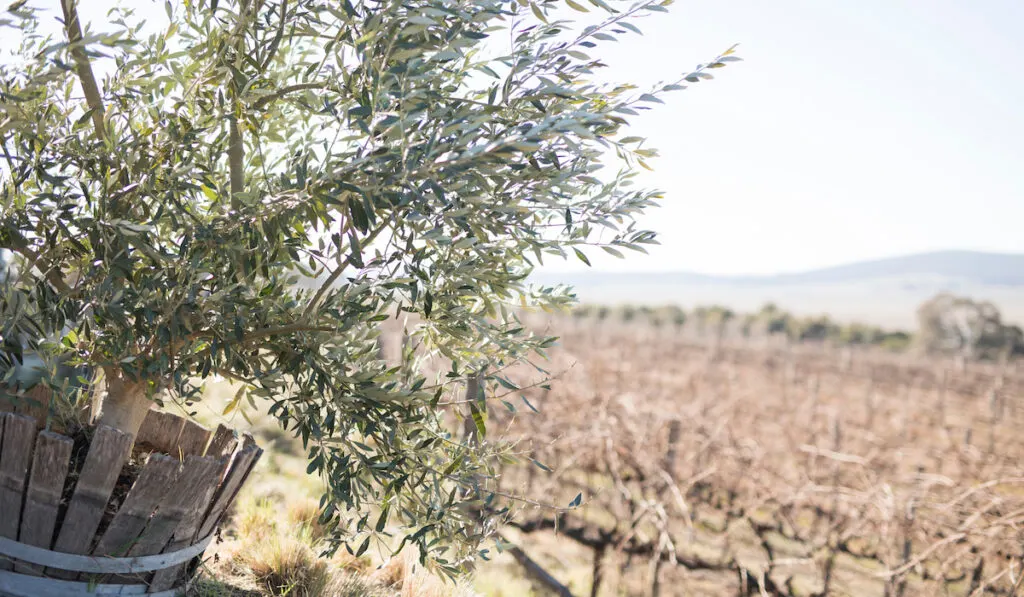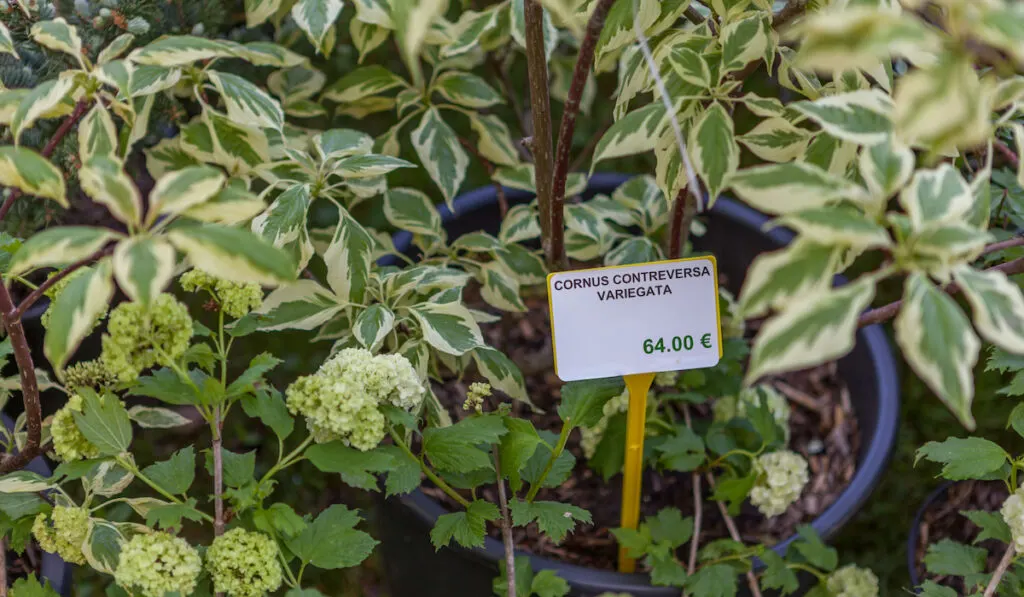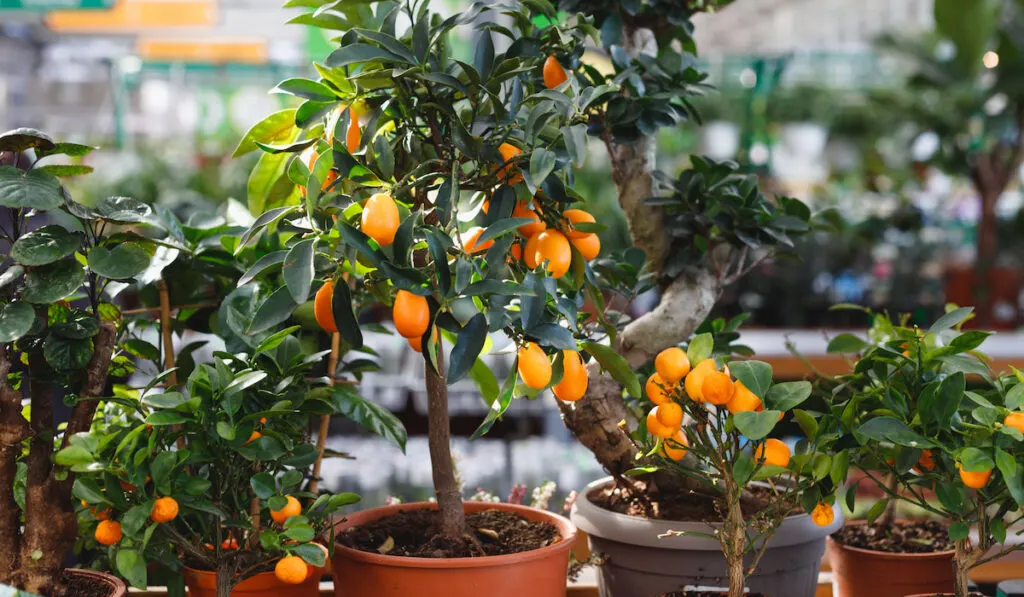Container gardening is a great way to improve the aesthetics and diversity of your outdoor garden with minimal work.
Numerous tree species are well-suited to container culture, so you can reap the tree’s many advantages while enjoying the added ease of tending to a potted plant.
Slow-growing or miniature species of trees are best for container gardening. One of the greatest advantages of growing trees in containers is moving the specimens inside during the colder months.
This allows you to grow species that would otherwise struggle to survive in your hardiness zone.
Many different kinds of trees can thrive in containers. Take a look at this list of the top five container-friendly trees!
Table of Contents
Essential details: List of 5 Large Potted Trees
| Name | Basic Information | USDA Plant Hardiness Zone |
| Japanese Maple | Height: 10 to 25 feet. Spread: 10 to 25 feet. Appealing leaves. Shade, indirect light. Low maintenance. | 5-8 |
| Olive Tree | Height: 20 to 30 feet. Spread: 15 to 25 feet. Mid- to low maintenance. Full sun. | 8-10 |
| Wedding Cake Tree | Height: 10 to 15 feet. Low maintenance. Full sun, indirect sunlight. | 6-9 |
| Citrus Trees | Height: 8 to 12 feet for dwarf citrus varieties. Fresh citrus fruits. Full sun. Mid to low maintenance. | 8-11 |
| Apple | Height: dwarf varieties 6 to 8 feet. Apple fruits. Full sun. Low maintenance. | 5-8 |
1. Japanese Maple (Acer palmatum spp.)

If you’re seeking a tree with gorgeous decorative leaves, Japanese maples should be your first pick, and you won’t have to look any further.
The variety of colors, sizes, and shapes of these trees is seductive, and you may soon find that your garden or patio will be filled with hues like lime green, yellow, and orange-red, only from Japanese maple trees.
A Japanese maple’s average annual growth rate is 1-2 feet. Growing rates are higher while they are young and decrease when the trees reach maturity.
Numerous attractive small forms of Japanese maple are suitable for container culture. They “self-stunt,” which means that when their roots are constrained, their top growth will be reduced.
However, when growing in a container, it is best to stick to small to medium varieties. Dwarf and bonsai-friendly Japanese maples are widely available.
The Best Japanese Maple for Containers
- Acer palmatum ‘Mikawa yatsubusa’.
- Acer japonicum ‘Green Cascade’.
- Acer palmatum ‘Geisha Gone Wild’.
- Acer palmatum ‘Rhode Island Red’.
- Acer shirasawanum ‘Autumn Moon’.
Needs of Japanese Maples
- Place them in a protected area, away from the harsh winds and intense sun.
- They require regularly moist soil with good drainage, which should never be too wet or too dry.
- Keep new plants safe from late-spring frosts.
2. Olive (Olea europaea)

Olive trees bring the bright, cheerful vibe of the Mediterranean into any and every home.
Olives, however, are hardy enough that they may grow in other climates as long as they are shielded from damp, cold winters. That’s why having your olive tree in a pot is ideal for convenient winter maintenance.
The health of your olive tree depends greatly on the spot you choose to place it. Olive trees need a sunny place with little wind to flourish.
It’s important to remember to rotate the container regularly so that the plant’s branches receive light from all angles. Olive trees growing in pots also need well-drained and well-structured soil.
Needs of Olive Trees
- Place them in a sunny location with little wind to allow them to thrive.
- Water carefully, letting the soil surface dry out in between waterings, and never letting the soil become waterlogged.
- Beginning in the second year, fertilize once every two weeks by mixing liquid fertilizer into the water supply and long-lasting granular fertilizer into the soil after repotting.
- Every two years for young plants and every five years for older ones is a good rule of thumb for repotting.
- Olive trees can be cut down to the size of a shrub if desired. Younger plants have a tendency to grow sparsely and hence require more frequent pruning. You can shape a young olive tree into a bushy crown or a more open shrub by pruning it.
3. Wedding Cake Tree (Cornus controversa)

Planting a wedding cake tree in a pot is an enjoyable way to add the exotic beauty of a tropical plant to your home. Its distinctive, layered leaves and beautiful, cone-shaped blooms make it an ideal ornament.
Wedding cake trees are tropical in origin, but they can be grown in any climate if given the right conditions in a container.
The wedding cake tree grows at a rate of approximately one foot per year, which is fairly slow. It develops an average height of 10 to 15 feet and grows best in well-drained, mildly acidic soil.
The wedding cake tree has a long lifespan, provided that it receives the necessary care and attention. This tree is hardy enough to survive light frost and breezy weather in spring.
Needs of the Wedding Cake Tree
- Plant in full sun or partial shade.
- They do best in moist but well-drained soil rich in organic matter.
- Be sure to give them enough water in the first several months after planting and during warm weather.
- If you want the tree to grow naturally into its famous tiered shape, you shouldn’t prune it unless you are removing dead or sick branches.
4. Citrus Trees

While citrus may be grown outside year-round in USDA Hardiness Zones 8–11, gardeners in cooler climates (Zones 7 and lower) may want to cultivate dwarf citrus trees in containers so they, too, can take pleasure in the juicy fruits of citrus trees.
This also makes it simple to relocate the tree to a more sheltered location out of the wind and rain.
Regular citrus trees outgrow their containers too quickly to be a practical choice for container gardening.
However, dwarf citrus trees are ideal for growing in containers since they may be pruned to maintain manageable sizes and thrive in confined spaces.
Although dwarf types and frequent trimming of your citrus trees can keep your tree from getting too big for its pot, most container citrus trees still grow to be about 6 feet tall.
The Best Citrus Trees for Containers
Kumquat varieties: ‘Fukushu,’ ‘Meiwa,” and “Tavares Limequat.’
Lemon varieties: ‘Improved Meyer,’ ‘Sungold,’ and ‘Variegated Pink.’
Orange varieties: ‘Washington,’ ‘Tarocco,’ and ‘Trovita.’
Needs of Citrus Trees
- To thrive, citrus trees require at least six to eight hours of solid light daily.
- Choose a soil mixture that is both light and well-draining.
- Any time of the year, besides winter, is fine for pruning citrus into whatever form is desired.
5. Apple (Malus domestica)

If you have a small garden, you can still enjoy fresh, home-grown apples by cultivating a tree in a large container. Although we usually consider apple trees quite large, certain types are essentially smaller.
There are several options to consider when deciding which apple tree to plant in a container, but dwarfing rootstocks, which limit the tree’s height to about 6 feet, are the most often used method.
Pollination is the second-most crucial factor when selecting an apple tree variety. Even if self-fertile cultivars exist, it is best to plant at least two different partner trees in close proximity to ensure a successful fruit set (cross-pollination).
If you want to plant apple trees in pairs, make sure they’re different varieties that bloom at the same time.
When growing an apple tree in a container, it is important to shape and train the tree to prevent it from becoming too large for the space.
So, think about whether you want to train the tree yourself or purchase a pre-trained columnar, cordon, or fan tree for the pot.
The Best Apple Trees for Containers
- ‘James Grieve’
- ‘Falstaff’
- ‘Sunset’
- ‘Cox’s Self Fertile’
- ‘Royal Gala
These can easily self-fertilize or produce fruit with the help of pollen from nearby apple trees or other decorative malus plants.
Needs of Apple Trees
- Full light is ideal for growing and ripening sweeter dessert apples or eating apples, whereas crab apples and tart cooking apples may typically tolerate dappled or partial shade.
- If you’re going to grow an apple tree, you need a very large and sturdy container.
- An apple tree in a container should be planted in a loam or soil-based compost mix.
- In the hot and dry summer months, regular and thorough watering is especially important.
Final Thoughts
Having read this article, I hope you have already settled on the ideal type of tree for your container.
Finally, here are some tips on maintaining large potted trees.
- Consider the maximum height and age of a tree species to get an idea of its potential size. Trees can be grown successfully in containers for their whole lives, while slower-growing types can stay in containers for quite some time before needing to be moved outdoors as part of your garden bed designs.
- Choose a container with drainage holes that is at least twice as broad as the root mass to increase the likelihood of your plant thriving in the new spot.
- In the spring, scrape out the top layer of soil and replace it with fresh loam-based compost to ensure the best possible growth of your trees.
- Remember that patio trees require more frequent watering than ground-grown trees because of the limited water supply and soil volume.
Resources
- https://www.homesandgardens.com/advice/best-trees-to-grow-in-pots
- https://www.gardenersworld.com/how-to/grow-plants/best-trees-to-grow-in-pots/
- https://jayscotts.com/blog/growing-trees-in-pots/
- https://www.gardendesign.com/japanese-maple/
- https://www.waysidegardens.com/how-to-planting-and-caring-for-japanese-maple-trees/a/329/
- https://www.gardenia.net/guide/great-japanese-maples-for-containers
- https://www.coniferkingdom.com/blog/japanese-maples-in-containers/
- https://www.finegardening.com/article/enchanting-japanese-maples
- https://www.missouribotanicalgarden.org/PlantFinder/PlantFinderDetails.aspx?taxonid=275408
- https://plantura.garden/uk/trees-shrubs/olive-tree/olive-trees-in-pots
- https://www.missouribotanicalgarden.org/PlantFinder/PlantFinderDetails.aspx?taxonid=283004
- https://www.littleupsidedowncake.com/creating-a-show-stopping-centerpiece-growing-a-wedding-cake-tree-in-a-container/
- https://www.pennington.com/all-products/fertilizer/resources/growing-container-citrus-fragrance-fruit-and-fun
- https://www.gardenworld.co.uk/case-study/growing-apples-in-pots-and-containers/
- https://www.orangepippintrees.com/articles/fruit-tree-advice/growing-fruit-trees-in-pots-and-containers
- https://horticulture.co.uk/apple-tree/containers/
- https://www.lovethegarden.com/uk-en/article/apples-malus-domestica
